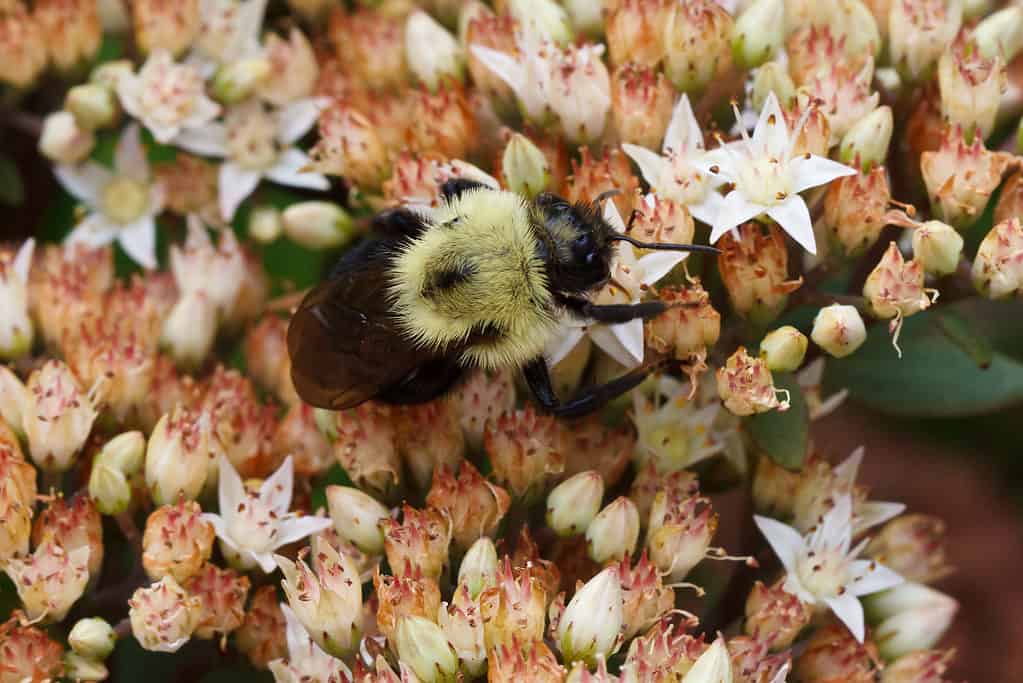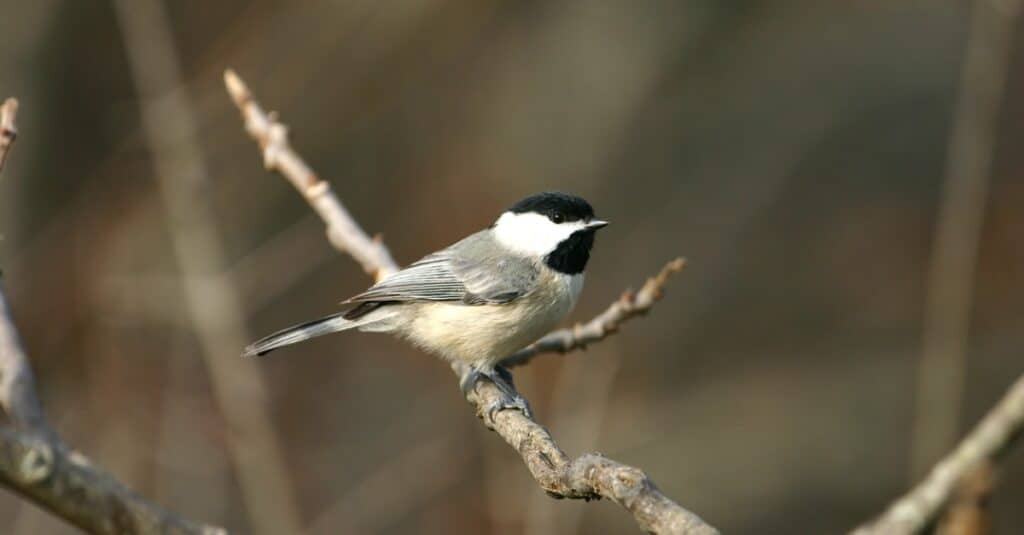Lemon Cuckoo Bumblebee
Bombus citrinus
Male lemon cuckoo bumblebees do not have stingers.
Advertisement
Lemon Cuckoo Bumblebee Facts
- Prey
- The half-black bumblebee (Bombus vagans), and the two-spotted bumblebee (Bombus bimaculatus)
- Main Prey
- The common Eastern bumblebee (Bombus impatiens),
- Name Of Young
- larvae
- Group Behavior
- Colony
- Fun Fact
- Male lemon cuckoo bumblebees do not have stingers.
- Estimated Population Size
- Undetermined
- Biggest Threat
- loss of host species
- Most Distinctive Feature
- lemon-yellow thorax
- Distinctive Feature
- aggressive queen behavior
- Gestation Period
- 6-8 weeks
- Temperament
- mild, except when commandeering a host nest.
- Wingspan
- 1 inch
- Training
- N/A
- Optimum pH Level
- N/A
- Incubation Period
- 3-5 days
- Age Of Independence
- 6-8 weeks
- Age Of Fledgling
- 6-8 weeks (emergence)
- Average Spawn Size
- 300-1000
- Litter Size
- N/A
- Habitat
- subterranean nests
- Predators
- Birds, small mammals, other insects, spiders
- Diet
- Herbivore
- Average Litter Size
- N/A
- Lifestyle
- Diurnal
- Favorite Food
- flower nectar
- Type
- Bombus citrinus
- Common Name
- Lemon cuckoo bumblebee
- Special Features
- hairy yellow thorax
- Origin
- North America
- Number Of Species
- 211
- Location
- Eastern United States and Canada
- Slogan
- N/A
- Group
- colony
- Nesting Location
- underground
- Age of Molting
- various times during larval stage
Lemon Cuckoo Bumblebee Physical Characteristics
- Color
- Yellow
- Black
- Skin Type
- Exoskeleton
- Lifespan
- # months - 1 year
- Weight
- less than 1 ounce
- Height
- 0.25 inches
- Length
- 0.75 inches
- Age of Sexual Maturity
- 6-8 weeks
- Age of Weaning
- N/A
- Venomous
- No
- Aggression
- High
View all of the Lemon Cuckoo Bumblebee images!
Bombus citrinus is distinctive for the lemon-yellow coloration of its thorax. The lemon cuckoo bumblebee is native to North America, primarily found in the Eastern United States and Canada. The species name is derived from the cuckoo birds, family Cuculidae, that lay their eggs in the established nests of other bird species. Lemon cuckoos are obligate parasites. Evolution has left them incapable of building their own nests. Instead, lemon cuckoo bumblebees depend on host bumblebees to provide the requisite necessities for rearing their broods. Keep reading to discover more about lemon cuckoo bumblebees.
Five Facts about Lemon Cuckoo Bumblebees
- Lemon cuckoo bumblebees are obligate brood parasites
- Male lemon cuckoos do not have stingers
- The species consists of queens and drones. There is no worker caste
- Lemon cuckoos have wingspans of up to 1 inch
- They do not have corbiculae, a/k/a pollen baskets
Scientific Name
Bombus citrinus is the scientific binomial name for the lemon cuckoo bumblebee. The first name, Bombus, is the genus that contains all 250+ species of bumblebees Bombus is Latin for buzzing. The second name, citrinus is the unique species name and translates from Latin to lemon, a reference to the color of the species thorax. The 28 species of cuckoo bumblebees were classified as the genus Psithyrus until 2006 when they were reclassified as Bombus. This change was made based on molecular data and morphological evidence. Psithyrus is now classified as a subgenus.
Lemon Cuckoo Bumblebee: Appearance
The lemon-yellow coloration from which the lemon cuckoo bumblebee gets its name is a prominent feature of its hairy thorax, with little of the color found elsewhere on its predominately black body. Bombus citrinus is on the large size. Lemon cuckoo bumblebees are approximately 0.75 inches long with a wingspan of approximately 1 inch. Typical of the genus, males are smaller than females and lack stingers. The wings are translucent with a dark brown or black band near their base.
As is characteristic of cuckoos, Bombus citrinus lack corbiculae, commonly called pollen baskets, in which to collect the pollen that is crucial to the survival and development of their larvae. The species also lacks the ability to produce enough wax to fashion honeycomb, another necessary component for developing offspring. Cuckoos no longer having functional wax glands or pollen baskets are evolutionary adaptations that have made them dependent on their hosts for the survival of their offspring and the species itself.

The lemon-yellow coloration from which the lemon cuckoo bumblebee gets its name is a prominent feature of its thorax, with little of the color found elsewhere on its predominately black body.
©Elliotte Rusty Harold/Shutterstock.com
Lemon Cuckoo Bumblebee: Behavior
Bombus citrinus is a species of queens and drones. There is no worker caste. Fortunately, a worker caste isn’t necessary, as the lemon cuckoo relies on the services of common bumblebee species to rear its young. As mentioned earlier, even if they wanted to raise their own broods, lemon cuckoo queens are incapable of doing so. Lemon cuckoo bumblebees are considered obligate brood parasites With neither pollen baskets nor functional wax glands, they are incapable of caring for their offspring.
Obligate Parasitism
Obligate parasites are dependent on their hosts for survival. Viruses and fungi are other examples of obligate parasites, but they are not brood parasites. Bombus citrinus are obligate parasites that lay their eggs in the nests of other bumblebee species. The eggs, once they have hatched, become the brood. This is why lemon cuckoos are called brood parasites. Once the eggs have hatched, the host colony takes care of the cuckoo’s larvae, feeding them the food that was intended for the host’s own young. While an effective solution for the lemon cuckoo bumblebee, it has negative, sometimes disastrous effects on the host colony.
Attacking the Nest
Lemon queen cuckoos are quite aggressive while commandeering a host nest. The evolutionary adaptations that render them incapable of rearing their brood, give them an advantage in the battle for dominance. A longer stinger, larger mandibles, and thicker armor make the lemon queen practically invincible. Once the lemon queen has scouted out the host nest, she will revisit it several times before attacking it. When she does attack, she swoops in killing the queen. In her efforts to dominate the worker caste, the lemon queen will display threatening behaviors including mauling. Mauling consists of the invading queen flying up against the worker caste, grabbing them and shaking them, while making overtures as if to sting.
Denouement
Once the lemon queen has achieved dominance over the host colony she removes any remaining host larvae, aggressively yanking them out of their brood cells. She then eats the host’s unhatched eggs. With the competition for the colony’s resources out of the picture, the lemon queen lays her eggs in the cells that have been prepared for the host’s eggs. After the lemon queen has laid her eggs she departs the nest, never to return. The lemon queen will spend the rest of her days peacefully foraging. Lemon cuckoo male bumblebees (drones) are born to mate. Such is the life of males of the species. They mate and forage; They forage and mate. And then they die.
Habitat
The ideal habitat for lemon cuckoo bumblebees provides a mix of flowering plants for foraging near the host’s nesting site. Lemon cuckoos and their host species, including the common Eastern bumblebee (Bombus impatiens), the half-black bumblebee (Bombus vagans), and the two-spotted bumblebee (Bombus bimaculatus) forage in grasslands, meadows, forests, and backyard gardens. They forage on a wide variety of flowering plants, including wildflowers, crops, and ornamental plants.
The nests of lemon cuckoo hosts are located in underground burrows, like abandoned mouse nests.
Lemon Cuckoo Bumblebee: Diet
Lemon cuckoos are herbivores that forage on a wide variety of flowering plants, including wildflowers cultivated crops, and ornamentals. As generalist foragers, Lemon cuckoo bumblebees will feed from an assortment of flora, including clover, lupine, vetch, and thistle. This species will also forage on a variety of cultivated crops, including raspberries, blackberries, apples, and cherries. Lemon cuckoo bumblebees forage on a variety of ornamental plants, including roses and dahlias.
Predators and Threats
Lemon cuckoo bumblebees face many predators, including birds, like chickadees and orioles. Spiders, like the goldenrod crab spider, will eat cuckoos that they snare in their webs. Small mammals, like squirrels and shrews, and insects, like wasps and flies, feed on lemon cuckoo larvae.
In addition to these natural predators, lemon cuckoo bumblebees face other threats, including habitat loss, disease, and agricultural chemicals, all of which have negative effects on lemon cuckoos. However, the number one threat to lemon cuckoo bumblebees is declining host populations.

Birds, like this Carolina chickadee, eat lemon cuckoo bumblebees.
©iStock.com/lgunderson
Conservation Status and Population
Bombus citrinus was most recently assessed for The IUCN Red List of Threatened Species in 2014, and at that time was listed as a species of least concern. However, in the intervening years, bumblebee populations have been declining at a rapid and alarming rate. And when the lemon cuckoo’s host species are gone, so are the cuckoos. Cuckoo bumblebee populations tend to fluctuate wildly and are not well documented making population estimates difficult to determine, but it is a safe bet that their numbers are trending down.
Lemon Cuckoo Bumblebee: Lifecycle
The female lemon cuckoo bumblebee emerges from her diapause or hibernation in late spring. Lemon cuckoo queens tend to emerge several weeks after their host species. This allows the hosts time to construct a nest and oftentimes have one brood of worker bees develop. Once the cuckoo queen emerges she will forage for a time allowing her ovaries to ripen, before she begins the search for a host colony.
Lemon queen cuckoos follow the scent of the worker caste back to their colonies. When the lemon queen has chosen the host colony, she will return several times before attacking the queen and killing her. With the host queen dead, the lemon cuckoo queen initiates her assault on the worker bees. Lemon cuckoo bumblebees will attack worker bees until they have acquiesced to her rule. With her dominance over the colony established, she will lay her eggs in the cells provided for the host’s eggs. Having laid her eggs, she leaves the colony.
Her brood is now at the mercy of the host colony which will nurture and care for them for the following 6-8 weeks through their larval and pupal stages. Once the newly adult lemon queens and drones have emerged, they forage and mate until the days grow shorter and the temperature begins to drop. At that time, queens individually find subterranean shelters in which to overwinter. The males (drones) simply die. When the mercury rises again in the spring, the lemon queens emerge to begin the lifecycle anew.
Up Next:
View all 98 animals that start with LLemon Cuckoo Bumblebee FAQs (Frequently Asked Questions)
What are the physical characteristics of a lemon cuckoo bumblebee?
Lemon cuckoo bumblebees are large, hairy bumblebees. The lemon-yellow coloration from which the lemon cuckoo bumblebee gets its name is a prominent feature of its hairy thorax, with little of the color found elsewhere on its predominately black body. Bombus citrinus is on the large size. Lemon cuckoo bumblebees are approximately 0.75 inches long with a wingspan of approximately 1 inch. Typical of the genus, males are smaller than females and lack stingers. The wings are translucent with a dark brown or black band near their base.
Are lemon cuckoo bumblebees aggressive?
Lemon queen cuckoos are quite aggressive while commandeering a host nest. The evolutionary adaptations that render them incapable of rearing their brood, give them an advantage in the battle for dominance. A longer stinger, larger mandibles, and thicker armor make the lemon queen practically invincible. Once the lemon queen has scouted out the host nest, she will revisit it several times before attacking it. When she does attack, she swoops in killing the queen. In her efforts to dominate the worker caste, the lemon queen will display threatening behaviors including mauling. Mauling consists of the invading queen flying up against the worker caste, grabbing them and shaking them, while making overtures as if to sting.
However, Lemon queens do not usually attack or act aggressively toward humans unless they are provoked. Once they have laid their eggs, they become quite docile.
What do lemon cuckoo bumblebees eat?
Lemon cuckoo bumblebees are herbivores that forage on a wide variety of flowering plants, including wildflowers cultivated crops, and ornamentals. As generalist foragers, Lemon cuckoo bumblebees will feed from an assortment of flora, including clover, lupine, vetch, and thistle. This species will also forage on a variety of cultivated crops, including raspberries, blackberries, apples, and cherries. Lemon cuckoo bumblebees forage on a variety of ornamental plants, including roses and dahlias.
What predators and threats do lemon cuckoo bumblebees have?
Lemon cuckoo bumblebees face many predators, including birds, like chickadees and orioles. Small mammals, like squirrels and shrews, and other insects, like wasps and flies, feed on lemon cuckoo larvae.
In addition to these natural predators, lemon cuckoo bumblebees face other threats, including habitat loss, disease, and agricultural chemicals, all of which have negative effects on lemon cuckoos. However, the number one threat to lemon cuckoo bumblebees is declining host populations.
Are lemon cuckoo bumblebee populations stable?
Bombus citrinus has most recently been assessed for The IUCN Red List of Threatened Species in 2014, and at that time was listed as a species of least concern. However, in the intervening years, bumblebee populations have been declining at a rapid and alarming rate. And when the lemon cuckoo’s host species are gone, so are the cuckoos. Cuckoo bumblebee populations tend to fluctuate wildly and are not well documented making population estimates difficult to determine, but it is a safe bet that their numbers are trending down.
Thank you for reading! Have some feedback for us? Contact the AZ Animals editorial team.
Sources
- wisconsinpolinators.com, Available here: https://wisconsinpollinators.com/Bee/BB_BombusCitrinus.aspx
- washingtonpost.com, Available here: https://www.washingtonpost.com/climate-environment/2020/02/06/bumblebees-are-vanishing-scientists-blame-climate-change/
- iucnredlist.org, Available here: https://www.iucnredlist.org/species/44937676/68983052
- wikipedia.org, Available here: https://en.wikipedia.org/wiki/Bombus_citrinus
- natureserve.org, Available here: https://explorer.natureserve.org/Taxon/ELEMENT_GLOBAL.2.819653/Bombus_citrinus
- fws.gov, Available here: https://www.fws.gov/species/lemon-cuckoo-bumble-bee-bombus-citrinus

















